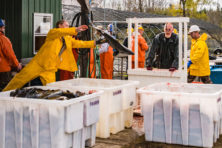Low Oxygen, Excess Fish Likely Cause of Fish Die-off at Strawberry Creek Hatchery
- Share
- Tweet
- Pin
- Share
Fisheries biologist Nick Legler said the 1,000-fish die-off in Strawberry Creek fish hatchery in Sturgeon Bay wasn’t caused by anything disastrous or sinister. It was just a matter of too many fish in the stream.
The hatchery is usually home to about 1,500 fish. On the weekend of Oct. 5, there were about 3,400 in the pond.
“Some of those fish that died could have been in the pond for three or four weeks,” Legler said. “Between that and the low oxygen they couldn’t take it and a bunch of them died.”
In the fall, Chinook salmon swim up Strawberry Creek to spawn in the fish hatchery. Fish biologists harvest eggs from the salmon to use in the DNR’s fish stocking program. Biologists also harvest fish, and donate the young, healthy ones to food pantries and send the older, unhealthy fish to a plant in Algoma that turns them into plant fertilizer. Extra eggs are sold to bait dealers.
The fish swim upstream to spawn and die, so when they get to the hatchery they’re already stressed and tired, according to DNR fish biologist Steve Hogler.
“It doesn’t take a lot to kill them,” he said. “In this case we probably just had too many fish in the pond, and we probably got some washout from the wetland that’s upstream from us that brought in a lot of material that had a lot of oxygen demand.”
When organic material breaks down it uses up oxygen in the environment. That happens a lot in wetlands, Hogler said, so when heavy rains wash material out of wetlands it can lead to low oxygen water flowing into streams like Strawberry Creek.
Hogler said the fishing wasn’t good this year, probably due to weird lake temperatures and a plentiful food supply that drew the salmon away from anglers’ bait. The poor fishing season likely contributed to the huge influx of fish that swam up Strawberry Creek, and the crowded hatchery.
“It’s a very unfortunate situation, [a die-off] is nothing we like to see,” Hogler said. “We’d rather have live, healthy fish in our pond. With the return we’re seeing this year, there was very little we could do about it.”
Hogler said the issue wasn’t related to low water levels because the hatchery has a pump to help maintain the flow to the hatchery.
“The water levels are good enough for them,” he said. “Salmon are very, very strong homers, so they have one thing on their mind – they’re coming back to spawn. They’ll swim up anything that has any sort of water in it. Unless there’s mud flats, there’s enough water for them.”

